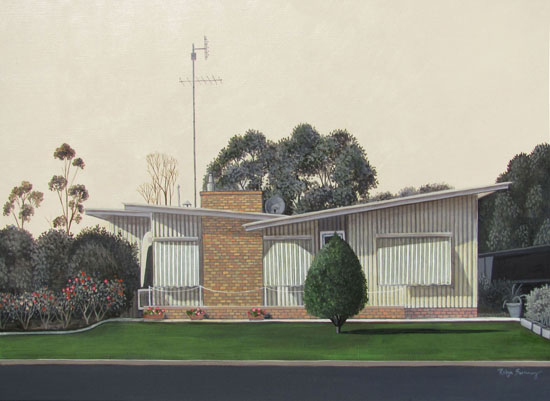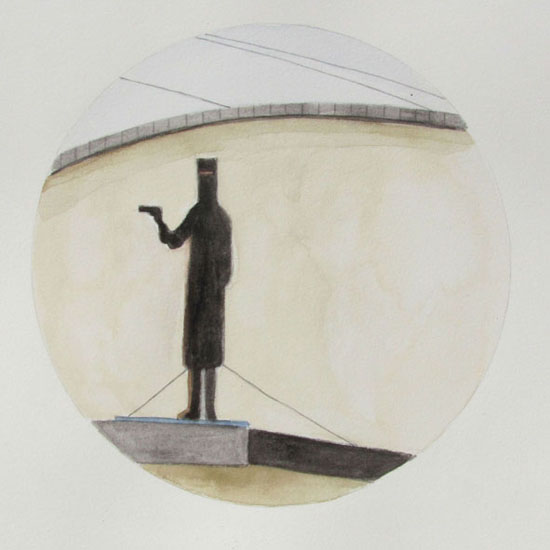Shane Wolff savours the exotic strangeness of Mullumbimby suburbia captured in Robyn Sweaney’s paintings…
Robyn Sweaney is well known for painting the houses in her hometown of Mullumbimby, a small but eclectic town on the far north coast of NSW, which nestles in lush green rainforest in the shadows of Mt Chincogan. She’s also ventured to other local towns like Lismore and Murwillumbah searching for ‘subjects’ for her work but to date has stayed within spitting distance of home. In doing so she has channelled Arthur Streeton (remember…we are still in Mullumbimby) and ‘looked in her own backyard’ for inspiration. In her latest exhibition, Sweaney literally takes herself and her painting out of their comfort zones. She embarks on a road trip from Victoria through the central and north-west areas of NSW, providing fertile material for a fresh take on some familiar ideas.
Robyn Sweaney, Varying The Elevation, 2011. Acrylic on linen, 47 x 67 cm.
It is almost impossible to visit Sweaney’s new exhibition Road Trip …from here to there ..and places in between without bringing to mind the depiction of Australian towns and suburbs by other artists – Chris O’Doherty (aka Reg Mombassa), Howard Arkley and Paul Davies to name a few. Each of these artists uses the vehicle of the Australian house (and/or suburbs) in different ways to examine deeper questions about culture and life in Australia, generally without the apparent use of a human element.
Although all these artists have at various times used the home as their subject, Sweaney’s paintings are unique and in recent years have resulted in her being chosen as a finalist in the Sulman, Wynne, Salon, Moran, Paddington and Country Energy prizes. ‘Road Trip’ is Sweaney’s ninth solo show and her first with Anthea Polson Art on the Gold Coast. The exhibition consists of a dozen or so acrylics on linen – depicting her well known houses, a School of Arts and a building that is home to a plumbing business. As a point of difference to her previous work, Sweaney has also painted several small landscapes in acrylic, and drawn a series of graphite works entitled ‘Stationary Point of Reference’ to highlight points of interest during her journey. Departures from established practice are always a little scary for an artist and Sweaney admits she had doubts about whether the landscapes and drawings were going to work – but within the scope of this exhibition they do work well. The landscapes centre the exhibition and the graphite drawings add more of the artist’s personality.
Sweaney is a realist but only to a defined extent. Her pictures of Australian homes are deliberate constructions of those she finds curious or worthy of painting for aesthetic reasons, or otherwise. The paintings are impressions of the landscape with a certain stripping back applied by the artist. Only the salient features remain in the composition – and unlike an advertising designer on Photoshop, what’s left behind might include power poles, handmade or old signs and faded colours – considered by the artist to be important parts of the landscape, and pertinent signals of time and place.
Robyn Sweaney, Stationary Point of Reference #6, 2011. Graphite and gouache on watercolour paper, 19 x 19 cm.
Although these houses are little different in style to those often chosen by Sweaney, there is something about the feel of these paintings that definitely doesn’t belong in the lushness of the northern rivers. It seems to me that the skies have a lot to do with this – in Varying the Elevation and Nesting Instinct in particular; the sky has yellow-grey tones bringing heat to mind so vividly that it feels almost like there is fire in the air. Instead of lush green vegetation, the houses have dark grey-green gums in the backyards. In a series of four small works (which includes Contentment and Number 10) the subject house is outlined against a very flat sky – the colour perhaps chosen to suit the composition, or an emotion, rather than reality. Like her subjects, the colours in Sweaney’s thoughtful palette have a vintage feel – faded blues, greens and sepia browns punctuated by the brilliance of rusty reds here and there throughout the exhibition. The pictures exude stories and invite the viewer to wonder what might have happened behind the facade.
Angus McDonald, this years Archibald prize [unofficial] runner up, who opened the exhibition says of Sweaney:
‘…her pictures of houses resemble still lives to me, except they are compositions partly composed by the people who reside in the houses rather than the artist herself which Robyn selects and then resolves in a way that suits her purpose. They are painted front on, like many still life works where the subject matter is placed geometrically on a bench or table. The view you are presented with is the one you always get as you are driving past a row of houses and glance sideways out the car window at the house immediately beside you. Robyn’s painting style is very direct. She doesn’t try to be clever. She works into the pictures only the parts she needs and dispenses with everything superfluous. That takes skill and experience to pull off successfully. But because she is such a great draughtswoman, they have weight to them and form.’
Each of the subject houses chosen by the artist takes on the personality of the owner despite the absence of humans in the frame. Sweaney paints her ‘still life’ subjects with a definite tenderness – selecting for special attention flowers like petunias and camellias, pathways, neat lawns, topiary hedges and curiosities such as the concrete kangaroo in Native Species. Some homes welcome visitors, others are little uptight or shy. All are small and quiet but no doubt provide ample enough space for a comfortable life. Or did. Each represents a harking back to more simple times before the McMansions, swimming pools and tennis courts of our new suburbs existed, and before global excess led to the current world financial crisis. Australian architect Glen Murcutt has said about Australian architecture that we are ‘trapped’ by our houses because we are not living in buildings that are serene. He is ‘interested in serenity, …in peace and …into making spaces that are of themselves calm.’ There is a certain paradox with this exhibition where in forcing us to look back perhaps Sweaney is giving us a way to move forward.
The title of this review is taken from the poem of the same name by Jean Kent. Many thanks to Angus McDonald for the use of the quote from his opening night speech.
Robyn Sweaney
Road Trip …from here to there ..and places in between
Anthea Polson Art
Gold Coast, Australia
Until 5 November 2011.



Pingback: Platforms for Legends: Robyn Sweaney’s ‘Road Trip’ « Wolff.
Thanks for such a thoughtful review! – I would love to see these works having read your wonderful description of them. Would you know if there is any chance of seeing them in Sydney?
Hi Laura,
Robyn has exhibited her work in Sydney in the past but unfortunately doesn’t do so at the moment. She’s says she’s working on it…
In the meantime you can see more at the gallery (Anthea Polson Art) website.
Sharne